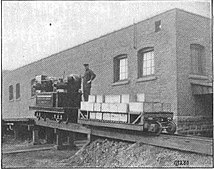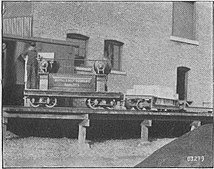CW Hunt Company

The CW Hunt Company was an American engineering company based in West New Brighton on Staten Island . The company manufactured trademarked "industrial" narrow-gauge railways as well as coal and ore processing machines. It also built railway tracks, quays, docks, warehouses, power stations and cranes, among other things.
history
The company was founded in 1872 by Charles Wallace Hunt (born October 13, 1841 - March 27, 1911). It was not as successful and well-known as other industrial suppliers, although it offered a well-considered range. The company, based in New York , supplied ropes, coal handling equipment, cranes and complete industrial railways. The innovative company was bought out by the Yale and Towne Manufacturing Company in 1920 , shortly after CW Hunt Co. produced a battery-powered forklift .
Products
The company sold steam and electric hoists, coal and ore handling machines, mast fittings, coal containers, lifting blocks, wheelbarrows, noiseless conveyors, bucket conveyors, automatic railways, cable cars, factory railways, coal conveyors for steam generation, Manila transmission cables, storage battery industrial trucks, coal and Ash gates and trolleys.
Industrial narrow-gauge railways
brand
The word "Industrial" was registered with the US Patent Office in 1493 by the CW Hunt Company as the Registered Trade Mark for their railway material and equipment. It was then illegal for other companies to sell or offer for sale railway material or equipment with this designation, or to write, print, or verbally mention a word similar to that brand on the material, whether or not a label was attached Not.
External wheel flanges
The industrial narrow-gauge railways of the CW Hunt Company had external wheel flanges in order to avoid curves, the development of noise and excessive wear of the wheel flange caused by the wheel flange running against the flank of the rail. In the case of small radii, the flange of the outer wheel ran on the upper edge of the outer rail, which was specially profiled for this. Since the flange has a larger diameter than the running surface of the wheel, the speed differences, which are considered disadvantageous in conventional wheelsets and which normally arise because the outer rail is longer in an arc than the inner rail, were compensated.
Publications
- CW Hunt Company: Coal Handling Machinery: No. 9306. 1893.
- Charles Wallace Hunt. American Society of Mechanical Engineers, President's Address 1898: The Engineer, His Work, His Ethics, His Pleasures. American Society of Mechanical Engineers, 1898.
- Charles Wallace Hunt: Manila Rope: Transmission and Hoisting. 1912.
- Charles Wallace Hunt: Heat Transmission in Poor Conductors. 1913.
Patents
- Patent US708713 - Hoisting apparatus , 1902.
- Patent US729868 - Hoisting apparatus , 1902.
- Patent US796074 - Coal-chute , 1905.
- Patent US1020607 - Motor-truck , 1910.
- Patent US1048834 - Conveyer , 1910.
Web links
- The Robert Pearson Collection: Industrial Suppliers - CW Hunt
- CW Hunt Locomotives and Industrial Railways, Staten Island, NY. Information gathered from AIMCo's archives CW Hunt trade catalogs 002, 072, 091, 11-5,12-1, 9503, 9817.
Individual evidence
- ^ Obituary: Charles Wallace Hunt. In: American Institute of Electrical Engineers, Proceedings of the. Vol. 30 (4), April 1911, pp. 140-141.
- ^ The Robert Pearson Collection: Industrial Suppliers - CW Hunt at narrowgaugechaos.com. Accessed 10-03-2015.
- ↑ Trade catalogs from CW Hunt Co .. Smithsonian Libraries Trade Literature Collections, American History Museum Library.
- ^ A b Narrow gauge railway made by the CW Hunt Company and sold under the trade name of "Industrial". Catalog No. 038, 1904. Pages 1 and 5.
Coordinates: 40 ° 38 ′ 22.3 " N , 74 ° 6 ′ 59.8" W.






